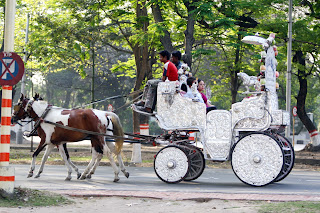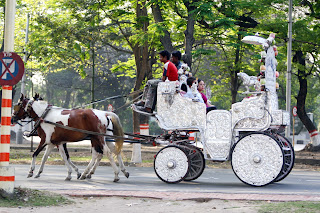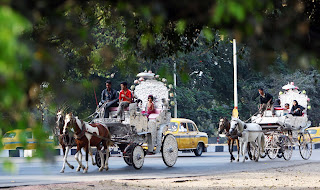Kolkata
Horse Carriages: A Ride Through History
While
wandering near the iconic Victoria Memorial in Kolkata, camera in hand, I
stumbled upon a nostalgic sight — beautifully adorned horse carriages parked
and trotting around, carrying excited tourists. As I spoke with the carriage
operators, I learned that rides typically cost between ₹500 and ₹700 for a
group of five, though rates can vary based on demand. For many of these
drivers, their livelihood depends entirely on these rides, which offer about 20
minutes of scenic travel starting and ending at the gates of Victoria Memorial
along Queens Way.
Horse-drawn
carriages are a treasured tourist attraction here, with around 50 still
operating in the area. They serve as a living reminder of Kolkata’s colonial
past, offering visitors a charming glimpse into a bygone era. Although the
number of carriages has dwindled over the years, they remain a beloved part of
the city’s tourism experience, particularly during the cooler winter months.
However,
concerns about the welfare of the horses have been raised by animal rights
activists. These discussions have led to proposals for alternatives, such as
electric carriages. Despite these concerns, horse-drawn rides continue to
survive, providing essential income for many coachmen and operators.
A typical
ride covers a scenic loop — from the carriage stand, past the Race Course South
Gate, through Fort William, and back. On request, some rides even extend up to
the picturesque Princep Ghat. The best time to enjoy this experience is between
5 PM and 8 PM, when the carriages and horses are splendidly decorated and
illuminated, creating a magical atmosphere.
Historically,
owning a horse-drawn carriage was a significant status symbol, reserved for
royalty, nobility, or the affluent. In earlier times, goods were transported by
horse wagons, but by the 1830s, horse-drawn buses and eventually trams
revolutionized urban transport, gradually overshadowing hackney carriages.
Today,
carriage drivers (known as coachmen, coachees, whips, or hackmen) typically
earn ₹25 per hundred rupees, with the remainder going to carriage owners. For
special events like weddings, they can charge between ₹600 and ₹700 per ride.
On a good day, a driver may earn between ₹2,000 and ₹3,000, though earnings can
fluctuate depending on tourist demand.
Horse
carriage rides are not unique to Kolkata. In cities like London, they have been
a cherished tradition for over 150 years, especially around Central Park and
Hyde Park. Even Queen Elizabeth II famously used horse-drawn carriages for
state and ceremonial events, with the Royal Mews at Buckingham Palace managing
these splendid vehicles. Her love for horses was well-known, beginning from the
tender age of three.
Thus,
horse-drawn carriages, deeply rooted in tradition, continue to charm and
connect us to a rich historical tapestry — not only in Kolkata but around the
world.
Photos and
Text by: Ashok Karan
ashokkaran.blogspot.com
Please like, share, and subscribe. Thank you!
#KolkataHorseCarriages
#VictoriaMemorial #KolkataTourism #HeritageRide #HorseDrawnCarriage
#ColonialKolkata #KolkataTravel #HistoricalRides #TravelPhotography #AshokKaran
#TraditionAndHeritage #CulturalJourney #StreetPhotographyIndia
#HorseCarriageRide #RoyalHeritage #TourismIndia




Leave a Reply